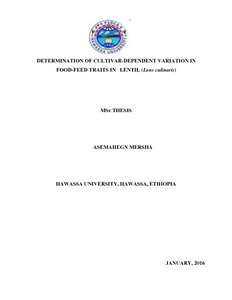Resource information
The study was conducted with the objectives of analyzing and evaluating of lentil varieties for haulm nutritional values, determining the relationship between fodder traits and agronomic traits, and developing Near Infrared Reflectance Spectroscopy (NIRS) equation for predicting nutritional value of lentil haulm. The samples were collected from Debre zeit, Akaki, Chefe Donsa and Minjar field experimental sites of Debre zeit Agricultural Research Center and the laboratory work was conducted at Animal Nutrition laboratory of the International Livestock Research Institute (ILRI), Addis Ababa. The study was conducted from January 2014 to April 2015. NIRS equation development was done using 633 haulm samples from preliminary and national variety trials. Only 315 samples of national variety trial were used for analysis of nutritional value on twenty seven testing and five control varieties using Random Complete Block Design (RCBD). Statistical analysis of the data was carried out using General Linear Model (GLM) procedure of Statistical Analysis System(SAS) software. The model developed by NIRS for the prediction of lentil haulm of crude protein (CP), metabolizable energy (ME), true in vitro organic matter digestibility (TIVOMD), ash and fiber fractions were accurate and successful method. In potential environment varieties (PE) haulm CP (11.53%), at Debre zeit, while crude protein yield (CPY)(0.42t/ha), ME(8.55MJ/kg DM) and TIVOMD(57.89%) at Chefe Donsa had the highest (P<0.05) values. In low moisture stress varieties (LMS) higher (P<0.05) haulm CP(9.90%) was obtained at Minjar, but higher values of CPY(0.38t/ha), ME(8.01MJ/kg DM) and TIVOMD(54.74%) were obtained from Debre zeit.In LMS Dz2012Ln0014 had the highest (P<0.05) CP (11.94%), TIVOMD (57.91%) and the lowest fiber fractions than controls, also higher in ME (8MJ/kgDM) contents than Alem Tena and local check. But, Dz2012Ln0013 had the highest(P<0.05) crude protein yield CPY). In PE Dz2012Ln0018 and Dz2012Ln0024 were the highest (P<0.05) in CP (10.05 and 10.19%), CPY (0.46 and 0.48 t/ha) and ME (8.6 and 8.58MJ/kg DM) contents than controls respectively. But, Dz2012Ln0019 had the highest (P<0.05) TIVOMD (59.45%) value. In the present study haulm yield and grain yield were positively correlated. CPY was positively correlated with all studied agronomic traits with the exceptions of grain yield and harvest index. ME and TIVOMD were positively correlated with yield and yield components. In LMS higher (P<0.05) grain yield was obtained from DZ2012Ln0004 (1.22t/ha), DZ2012Ln0001(1.07t/ha)and DZ2012Ln0005 (1.02t/ha) than controls.DZ2012Ln0005 (4.83 and 2.55t/ha), DZ2012Ln0013(4.67 and 2.46t/ha), DZ2012Ln0012 (4.43 and 2.42 t/ha) had significantly higher (P<0.05) values of haulm yield and haulm digestible dry matter yield than controls respectively. In PE Derash (2.81t/ha) had the highest (P<0.05) grain yield followed by Alemaya(2.09t/ha) andDz2012Ln0016(2.01t/ha). Significantly high (P<0.05) haulm yield and digestible dry matter yield were obtained from Dz2012Ln0017(6.52 and 3.70t/ha) and Dz2012Ln0026(5.99 and 3.36 t/ha) respectively. Varieties with high haulm nutritional value were not found to be high in their potential utility index that may be, because of their lower values of harvest index due to infestation of mild parasites and incidence of diseases.



